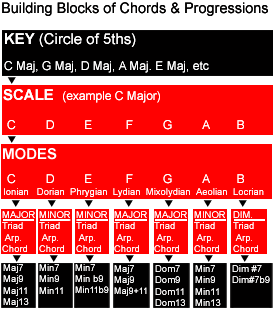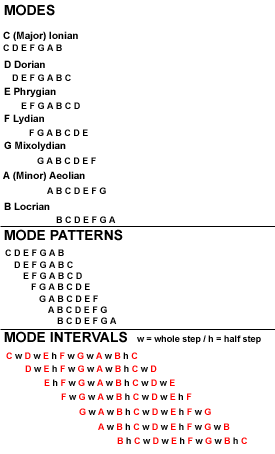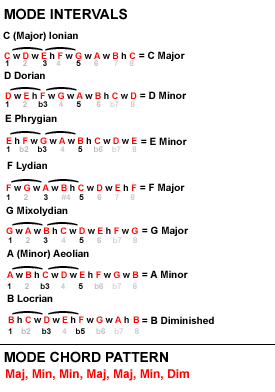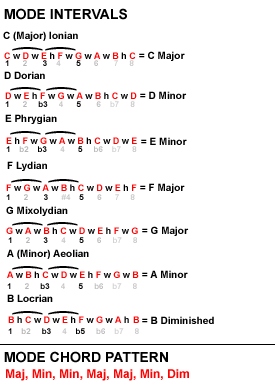| Lesson Subject:
Understanding Chords |
| What you learn:
Scales/Modes |
| Teacher: Michael Johnson |
Michael: This lesson covers part 3 of
Understanding Chords so far we've covered:
1. SCALES
and breaking them down into TRIADS, ARPEGGIOS and CHORDS.
2. Covering the CIRCLE OF 5THS and
how to establish KEYS.
In this
lesson you'll learn how to apply the SCALES and MODES to CHORD PROGRESSIONS.

Michael:
There are many pieces
of a puzzle that relate to each other. This lesson will continue on the
foundations explained in the earlier lessons. Let's get started, we'll use the C
MAJOR scale, notice how I show the same scale, only one is extended on the 5th
string.
Michael:
Now do any of you understand or studied MODES before? Modes will help you
understand where the chords come from.
Ralph: Yes, with Frank Gambale.
Michael:
Wow! Frank Gambale is a master at modes. Here's a chart showing the MODES in C.
Modes Chart 1

Michael:
Beginners, don't freak out, I'll break this down as the lesson progresses.
Ralph:
Frank calls these moods.
Michael:
Yes Ralph, very good point! To start with you take 7 notes of the C Major scale
C D E F G A B and start from a different note using the same note pattern, i e; C D E F G A B, D E F G A B
C, E F G A B C D, etc.
Michael:
Do you understand this
concept?
jlancaster:
YAHHH!
emily:
got it
Michael:
When you play these
same notes in a different order you create a MODE, or different sound or MOOD. Notice
how the
mode intervals change half step and whole-steps patterns. Here's the
notation so you can visualize them on the fretboard.
Michael: Notice as you move
the positions up the neck while they share all the same notes. Here's a tab
notation where the notes do not stay up. Do you follow me so far?
Ryan: yea
Glenn:
yes
Michael:
Now each of these MODES can be broken
into TRIADS, ARPEGGIOS and CHORDS. These chords are what makes up a CHORD
PROGRESSION. This is what SONGS are based on. This formula will allow you to
figure out songs on your own or write your own compositions, this is the secret to
writing songs!
Ralph: This is
true
Michael:
Now here's a chart on the modes and
chords.
Modes Chart
2

Michael:
Notice how each MODE is broken down into a pattern and then shows the 1, 3, 5 for each pattern.
The 1 3 5 = Major, the 1 b3 5 = Minor, and the
1 b3 b5 = Diminished. These patterns establish what chord, triad or arpeggio is played over each mode.
Ralph:
Sounds like triads to me.
Michael:
Yes they are! First I will simplify by finding
the triad, this gives you the main notes that are in the arpeggio and chords. This tab
notation shows each mode and then the
arpeggio.
Michael: VERY IMPORTANT
to remember the order of chords: MAJ, MIN, MIN, MAJ, MAJ, MIN,
DIM
Ralph:
essential
Michael:
If you remember that one thing, you'll be
able to figure chords out in any KEY
quickly.
Michael:
This tab allows the notes to stay up so you can see the patterns building
is anybody lost?
Ralph: No, this formula remains constant in all
keys.
jlancaster:
Give a song ex. so I can relate.
Michael:
Correct Ralph. JL I will very
soon! First let's break down each mode into the SCALE PATTERN, TRIAD,
ARPEGGIO and CHORD so you can visualize how this works. I use the C Ionian
(Major) for this illustration:
Michael:
See how that works. First the scale pattern C D E F G A B, then triad C E G, and
arpeggio C E G C E G.... Playing all these notes at once forms the
CHORD. Here's the same concept in the D Dorian.
Michael:
Notice how the MOOD of this scale, triad, arpeggio and chord change. This mode
(or mood) has a
sadder sound. This is because of the b3 note which is called a Minor
3rd. Remember our main formula MAJ, MIN, MIN, MAJ, MAJ, MIN, DIM.... keep that
in mind as you go through these patterns. Next is the E Phrygian:
Michael:
Now F Lydian:
Michael:
Now the G Mixolydian:
Michael:
Now A Aeolian which is called the RELATIVE MINOR:
Michael:
And now the last pattern, B Locrian. Notice the 1, b3 & b5 which is the pattern
used in the Diminished.
Michael:
Here's our chart again. See if the chart makes more sense after going through
the the modes.
Modes
Chart 2

Michael:
Here's all the chords, now do you see where all the chords in the KEY of C came from?
Glenn: yes
Michael:
So basically in the KEY of C, most songs
would use the C Major, D Minor, E Minor, F Major, G Major, A Minor and B Diminished.
Now let's make
up a few chord progressions to illustrate this concept. In this first
progression we'll pick these chords; C Maj, Em, Dm,
G Maj and Am.
Michael:
Now you can create any number of chord progressions by rearranging these related
chords. This also applies to
open chords as well.
Michael: See how it works?
Glenn: How about Am and Em.
Michael:
Sure, here's the Am and
Em.
Live Sample
1
Michael:
OK, who's next. Who wants to pick out the chords in the next
sample.
jlancaster: How about Em, Bm, A, Am, G.
Michael:
Cool, but start with either C Maj
or Am. That sets the key generally, remember you have C Dm Em F G Am B dim to
pick from. A and Bm will not work, because it doesn't come from the list of
chords that we established in the patterns we've been working on.
jlancaster: C, F, Em
Michael: OK JL, what style JL? rock or
folk?
jlancaster: Rock
Michael: Here you go!
Live Sample 2
Michael:
Anybody else?
jt: C
Maj,
F Maj, D Min,
more of a ballad though.
Michael:
OK, here you go.
Live Sample 3
Ralph: Dm9 to G13 to Cmaj9.
Michael:
Thanks Ralph, here's you go.
Live Sample
4
Ralph: On
live sample 4: you play D dorian over the dmin, over the
the g7 you can play G mixolydian
Michael:
Yes, the Dorian sounds cool, I don't have my multi-track to create the improve
layers.
jlancaster: I like that last one!
Michael:
Thanks everybody, see you next lesson!
jlancaster: thnx teach!
jt:
thanks teach
Ralph: thanks
again
|
<< load notation from left
|